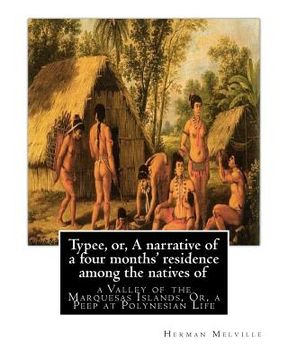Typee, or, A narrative of a four months' residence among the natives of: valley of the Marquesas Islands, or, a peep at Polynesian life, By Herman Mel (en Inglés)
Reseña del libro "Typee, or, A narrative of a four months' residence among the natives of: valley of the Marquesas Islands, or, a peep at Polynesian life, By Herman Mel (en Inglés)"
Typee is "in fact, neither literal autobiography nor pure fiction". Melville "drew his material from his experiences, from his imagination, and from a variety of travel books when the memory of his experiences were inadequate." He departed from what actually happened in several ways, sometimes by extending factual incidents, sometimes by fabricating them, and sometimes by what one scholar calls "outright lies".The actual one-month stay on which Typee is based is presented as four months in the narrative; there is no lake on the actual island on which Melville might have canoed with the lovely Fayaway, and the ridge which Melville describes climbing after escaping the ship he may actually have seen in an engraving. He drew extensively on contemporary accounts by Pacific explorers to add to what might otherwise have been a straightforward story of escape, capture, and re-escape. Most American reviewers accepted the story as authentic, though it provoked disbelief among some British readers.Two years after the novel's publication, many of the events described therein were corroborated by Melville's fellow castaway, Richard Tobias "Toby" Greene.Typee may have provided the writers Louis Becke, Jack London, and Robert Louis Stevenson with the themes and images of the Pacific experience: cannibalism, colonialism, cultural absorption, exoticism, natural plenty and beauty, and a perceived simplicity of native lifestyle, desires and motives.The inaugural book of the Library of America series, titled Typee, Omoo, Mardi (May 6, 1982), was a volume containing Typee: A Peep at Polynesian Life, its sequel Omoo: A Narrative of Adventures in the South Seas (1847), and Mardi, and a Voyage Thither (1849). Herman Melville (August 1, 1819 - September 28, 1891) was an American novelist, short story writer, and poet of the American Renaissance period best known for Typee (1846), a romantic account of his experiences in Polynesian life, and his whaling novel Moby-Dick (1851). His work was almost forgotten during his last thirty years. His writing draws on his experience at sea as a common sailor, exploration of literature and philosophy, and engagement in the contradictions of American society in a period of rapid change. He developed a complex, baroque style: the vocabulary is rich and original, a strong sense of rhythm infuses the elaborate sentences, the imagery is often mystical or ironic, and the abundance of allusion extends to Scripture, myth, philosophy, literature, and the visual arts. Born in New York City as the third child of a merchant in French dry goods, Melville's formal education ended abruptly after his father died in 1832, leaving the family in financial straits. Melville briefly became a schoolteacher before he took to sea in 1839 as a common sailor on a merchant ship. In 1840 he signed aboard the whaler Acushnet for his first whaling voyage, but jumped ship in the Marquesas Islands. After further adventures, he returned to Boston in 1844. His first book, Typee (1845), a highly romanticized account of his life among Polynesians, became such a best-seller that he worked up a sequel, Omoo (1847). These successes encouraged him to marry Elizabeth Shaw, of a prominent Boston family, but were hard to sustain. His first novel not based on his own experiences, Mardi (1849), is a sea narrative that develops into a philosophical allegory, but was not well received. Redburn (1849), a story of life on a merchant ship, and his 1850 expose of harsh life aboard a Man-of-War, White-Jacket yielded warmer reviews but not financial security........
Herman Melville (Nueva York, 1 de agosto de 1819-Nueva York, 28 de septiembre de 1891)1 fue un escritor, novelista, poeta y ensayista estadounidense, del período del Renacimiento estadounidense. Entre sus novelas más conocidas están Taipi (1846), basada en sus experiencias en la Polinesia, y la novela Moby Dick (1851),1 considerada su obra maestra y un clásico de la literatura universal.
Entre 1853 y 1855, publicó en la revista Putnam Magazine una serie de relatos, reunidos la mayor parte de ellos en The Piazza Tales, entre los que se encuentran dos de las narraciones más importantes de Melville: el cuento Bartleby, el escribiente y la novela corta Benito Cereno. También aparece el relato Las encantadas, compuesto de diez bocetos sobre las islas Galápagos unidos por un solo narrador. En 1857, El estafador y sus disfraces, también conocido como El embaucador (The Confidence-Man), fue el último trabajo de ficción en prosa que publicó. Buscando estabilidad económica, abandonó el oficio de escritor, aceptando un puesto como inspector de aduanas.
En sus últimos años, en los que tuvo que padecer además de la muerte de dos de sus hermanos también la muerte de dos de sus hijos, Clarence, por tuberculosis y Malcolm por un posible suicidio, además de la muerte de otro de sus hijos a los treinta y cinco años, Stanwix Melville, se dedicó a escribir poesía. Battle-Pieces and Aspects of the War, de 1866, es una reflexión poética sobre la Guerra de Secesión y Clarel: A Poem and Pilgrimage in the Holy Land, un poema épico de ficción, publicado en 1876. La novela Billy Budd, que dejó inconclusa y fue publicada póstumamente en Londres en 1924, es considerada una de las obras de mayor relevancia de la literatura estadounidense.
Ver más
Ver menos

